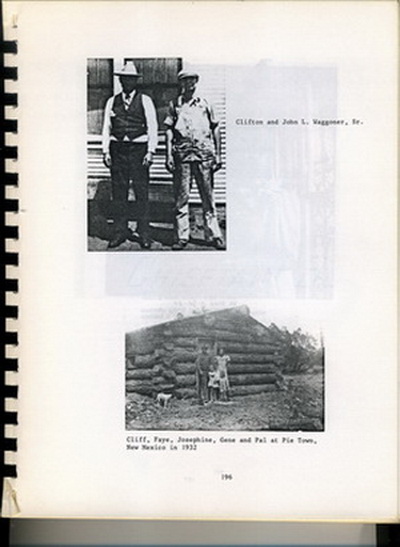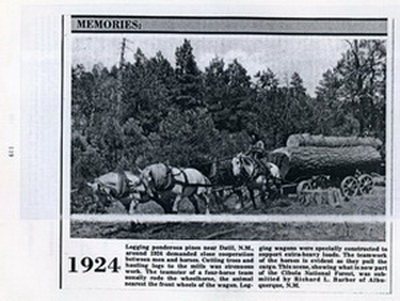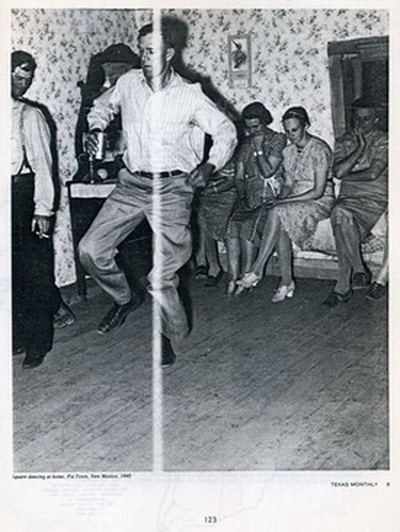Homesteader Stories
Clifton Waggoner
Margaret Josephine was born October 30, 1927, at Vernon, Texas. She died December 25, 1969, in Electra, Texas of diabetes. She married William R. Weathersby, the son of Marie Christina Neilson (Danish-Swedish descent). Her father was [________] Weathersby. Josephine "Jo" and Bill had two daughters: Rene Jill "Kissie" and Dana Chris. Rene Jill was born December 12, 1949, in Electra, Texas. She married Ronald Bledsaw (born at ). They had three children: Ronald Craig (born January 15, 1969 ), Mathew Shane (born July 1, 1976) and Amie Christine (born May 4, 1967). All three children were born in Tulsa, Oklahoma. Dana Chris (born May 28, 1955 at Witchita Falls, Texas) married (born at ) on at . They had children.
The second child of Cliff and Faye was Billy Gene (born January 8, 1930 at Electra, Texas). He married Louadah Gimlin (born December 15, 1933 at )on September 1, 1951 at Yuma Arizona. She is the daughter of Palmer and Grace Marrow Gimlin of Electra, Texas. To this marriage were
[=======================two pages missing==================================]
to protect the rig and contents. Therefore, he and his family went to this small settlement called, Newton, Texas, as a guard. They decided to enjoy the freedom of the outdoors and cooked over a campfire. They had a large hay trailer with a top over it for shade in the daytime or night cover and beds at night. Staying out like this, they all were really suntanned.
January, of 1933, was very cold and windy. Cliff, Faye and two small children (Jo and Gene) moved to Pie Town from Vernon. They moved into the house with Cliff's mom and dad. Already in the small log cabin were eight people; now there were 12. Dad said they would build Cliff and Faye a log cabin as there was lots of timber and brush. Dad and Clifton went to the saw mill in the Dodge truck to haul the split tree halves and slabs. Dad, Clifton, Charlie, Bud, John, Cletus and Jr. all helped. Faye had to drive four mules on the north side of the house. There were used to pull the long ridge pole up. All hands were helping. Thirty foot peeled logs were used to build the roof. Dirt, grass, gravel and whatever were used to fill the cracks. The windows were small slabs that opened out and, were proped open with a stick on leather hinges. A 55-gallon drum converted into a heating stove. A small four-eyed cookstove set on a large wooden box. It had a tiny oven and fire box. The table and benches were built from smooth slabs. Doors were made of slab lumber with leather hinges. There were dirt floors that they wet with water and would become as hard-as concrete. You could then sweep them with a broom. There was a bench built beside the heating stove with pillows on it which made it very comfortable. As there were no screens on the doors and windows, when they were open you had to watch for deer, coyotes or other wild animals as they would jump into the house through the window.
The children would try to have kittens to play with, but the owls would carry them off. Keeping chipmunks, squirrels or other small animals out of the house was constant work. Dad saw that everything was built for warmth—keeping out the snow or rain in the cracks of the house.
Every drop of water we used had to be hauled. They decided to try to drill. A drilling unit was rigged up using one of the back wheels of the truck for a pulley with the engine running it. He drilled several holes, quite deep, but found no water and gave up drilling.
Ice, food, fuel and water were carried to them by company employees. Cliff took time to kill rattlesnakes—and there were some big ones, too—also rabbits and birds. This was quite a good experience for the kids.
Clifton had to go to this small town of Pie Town to do the family shopping. There was a general store where you bought clothes, food, gasoline or whatever you needed. In February, 1933, Clifton took his family with him to town. Josephine, and Billy Gene were both blonde and curley headed. Jo was four and Gene was two. While Faye and Clifton were in the store shopping, the kids were left in their Dodge sedan. While Clifton and Faye were trying on shoes, some Indians were going to the commissary for supplies. They stopped in Fie Town to get food and gas. The Indians got out of the transort and were all over town. Being fascinated by the car, they were all over it. All this commotion awakened the sleeping children. Being frightened, they began to cry. The Indians wanted the little blonde girl with the blue eyes.
Riding horseback to Pie Town, which was seven and a half miles, was a nice outing if one had a saddle to use and if the horse hadn't been trained to jump cattle guards and brush fences. Gladys, Nannie Lee and Gladys's two girls, Beatrice and Else, were out gathering nuts in the woods. They
were robbing a packrats nest of nuts, when, over the ridge they could see what looked like feathers of an Indian. They could see these "feathers" moving behind a fallen tree. Being frightened, the girls ran to their horses to ride away when they looked back and saw it wasn't Indians or feathers, but it was wild hogs. Their ears were sticking up above the tree.
Dad said they would just try farming and hunting. Corn, beans, squash and other vegetables that had a short growing season were tried. We had a good supply of small game. Dad, Charlie, Clifton and Uncle Otis would go different places hunting and trading. This way they met lots of people and learned how others got by.. A large deer would not last long with so many of us to feed.
The domesticated animals were always thirsty and kept someone busy hauling water. Of course, Reina had a time with water herself with so many to cook and wash for. She had a huge range in the kitchen with a water reservoir and a warming place on the top. Trying to keep wood, water and extra food cooked ahead was a full time job.
Sewing, cooking, training children, keeping them in school and Sunday School left very little time for rest for a rather thin woman with beautiful brown hair, large lovely eyes and a welcome smile that was full of love and understanding to any and all. She was never too busy or too tired to stop and pick up a little one or help Dad in his many chores. A mother in every sense of the word. No one had time or maybe a thought of how many steps she took or all the things she did. Could there ever be enough love or compassion for a lady such as she? Yes, she held a very big family together. I, for one, hope her reward was great when she went to live with Jesus. Such a gentle person is always a loss to people in this world.
The open range had wild horses and the men went out whenever possible to catch and break them for their own use or to trade. So many of these people had homesteads and needed stock for work. There was always a thrill in the drive and capture of these beautiful ponies. Most all the horses the Indians had were captured wild and broken. The Indians usually had horses to trade or sell to the homestead people. Our families learned how to hunt and trap in different ways.
On our Mesa, the Indians were friendly. They expected to be invited to eat or spend a night when passing through. Our western code was that a family being gone never locked a door. If a person came by he was welcome to come in and use the fuel, food or beds, but leave them in good condition. Very seldom was this hospitality abused. The Indians in the area were friendly and helpful. They taught the different families how to preserve corn. When the milk would form in the young ears, take a board, tin or whatever--even a sharp knife and cut the corn off the cob. Scatter over this prepared surface and put to dry—turning every 2-3 days. When all this was completely dry, pack in jars, if possible. If not, put in tin containers or pack in dried areas in the ground and seal out all air, if possible, then. when ready to use, take one or two or more cups of this corn and place in a bowl or stewer and cover with cold water. Set overnight. Cook slowly for 35-40 minutes. This was like eating fresh corn. Also, they took pine-cone nuts, mesquite beans, berries and at times cactus apples and put them all together and beat into a mealey contene; water was added and cooked together to made bread.
Lots of flowers, some we called weeds, were used for medicine. Also, the different colored flowers were used to make dyes by boiling them. This dye was used to dye their threads to be used in hand-woven rugs and things. All skins were kept and used for their hogans, wigwams or brush homes. Nothing was ever wasted. On this high Mesa, water was very scarce. When it rained or snowed, they would keep the run-off because wells or water-holes were far apart.
Where money and food were both scarce, everyone had a meat pole that reached above the fly-line. The common fly only goes so high in the air, especially in the mountains. It made it easier to hang their meat high, out of the reach of flies.
Even when deer was out of season, a person going outside early in the morning might see a half of a deer swinging high on their meat pole. No one ever asked questions.
Everyone appreciated fresh meat and didn't want to get their neighbors, whether they be near or far, into trouble.
Panthers were very plentiful and they were bad thieves. Everyone hung their fresh meat of beef or hogs on the outside of the house. These panthers were large and fierce. They were seen carrying a side of bacon or a ham in their mouth for a long way and never dragged it on the ground.
Chickens, young pigs, cats or dogs weren't safe from the panthers and owls (which were also very large) were eaten by them.
Faye was only 16 years old when she and Clifton married in Vernon. They moved to Dimmitt in the house with his family who lived in an old two-story ranch house. Reina taught Faye how to cook as she had not yet learned.
There were 11 people co cook and wash for each day. A large garden that was irrigated from windmills grew lots of healthy vegetables. Canning of huge tomatoes, corn, beans, okra and peas was also in the teaching. There was also a time to make chocolate fudge, popcorn and taffy.
Fun to be had and enjoyed without even a radio, TV or record player. But there were neighborhood parties, dances and picnics. Not all land was under fencing and it was not unusual for cows, sheep or horses to be in your yard when you came out in the morning.
Cooking pumpkin to make pies, in which Reina was so good at making. Also, cheese, vinegar and buttermilk pies and bisquits so big and fluffy they would melt in your mouth. Of course they were made by hand. How else?
All of the older Waggoner women were wonderful cooks. They even compiled a large and very knowledgeable cookbook which sold alot of copies. They had a club in Elliott Community known as the "The Homemakers Cookbook".
At a farm north of Bowie, Pat, Cliff and Jack had the bedroom together and a snake always got in bed with them and they thought it was each other--and would kick each other. One night they saw it go up in the ceiling corner. They grabbed a gun and shot the snake and blew the roof off at the same time. Dad was so mad!
There was a creek that ran through this farm that was northwest of Bowie. The boys loved to fish, swim and water the stock from it. At night they would go coon or possum hunting and at times they had their own horses racing. It was quite a ways to get on the bus to go to the Bowie school. Later the farm was sold. Oil was found there and there was great demand for the land. On this place were trees that would be used for firewood.
In New Mexico, between our house and Uncle Otis's, there lived some close friends--Mr. and Mrs. Hull (from Texas, too). They had a lovely little girl named Nancy and they ere expecting another baby. There was no doctor closer than 67 miles. The neighbor women and friends usually went to help—taking food and bedding--to stay until the baby was born. So, coming from Uncle Otis's one day with a truck load of fresh water from his windmill, Clifton, Faye and two children, stopped at the Hulls and found they had a new baby girl, but she was not expected to live as she was a blue baby. So weak, life almost gone, they were trying to find some real whiskey—not moonshine—well, when Cliff and Faye left Texas, her brother Frank had given her a new bottle of bonded whiskey which had never been opened. They went after this bottle. A few drops mixed with warm water and sugar were fed to the baby several times a day for three days and nights. The baby overcame her weakness and was able to nurse and was saved to live a normal life. Of course, this formed a closer bond of friendship between the two families.
Cliff and family moved to Electra where they raised their children. Josephine passed away and is buried in Electra. Gene and his family live in Lubbock, Texas. Faye lives in Vernon. Cliff passed away and is buried in Tahoka, Texas—beside his dad.
... [end of Pie Town relevant part of narrative]
| From Top Left: 1. Clifton and John L. Waggoner, Sr. 2. Cliff, Faye, Josephine, Gene and Pal at Pie Town, New Mexico in 1932 3. Logging ponderosa pines near Datil, NM around 1924 4. Square Dancing |
|||




